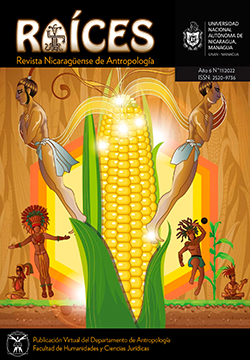Conflict of the bambas in Peru: Frame Analysis of ethnocentrism
DOI:
https://doi.org/10.5377/raices.v6i11.14501Keywords:
Discourses, ethnocentrism, framing, conflict, simplificationAbstract
The article contributes to the reflection on the Las Bambas conflict in Peru, the objective was to analyze the logic that makes the media prioritize certain issues in the construction and dissemination of their discourses regarding the Las Bambas conflict and in this process to question the invisibility of the underlying problems linked to the conflict. Thus, on the one hand, based on framing analysis to identify what the most-watched television media in Peru prioritize, and on the other hand, ethnocentrism as a theoretical approach to reflection the logic behind such prioritization of contents, the essay analyzes the framing of the Las Bambas conflict from the media. This shows that behind the hierarchization of the actors in the conflict and their roles; the invisibilization of others and their demands and what the media do not say about the conflict, issues related to environmental protection, exist an ethnocentric logic based on hegemonic categories expressed in simplifi cations and generalizations that are legitimized because they represent the beliefs of Peruvian society about the rural communities. Finally, these findings demonstrate that media discourses can validate and reproduce power structures that place the population affected by mining activities at a disadvantage.
Downloads
825
References
Amadeo, B. (2012). La teoría del framing. Los medios de comunicación y la transmisión de signifi cados. Revista de comunicación Vol. 1.
Bocanegra, H., & Ramirez, O. (2006). Impacto de los programas de estabilización y ajuste estructural en la financiación de la educación pública. Diálogos de saberes ISSN 0124-0021, 33 52.
Chihu, A. ( 2018). Los marcos de la experiencia. Sociológica, año 33, número 93, 87-117.
Consulting, L. (2018). Estudio cuantitativo sobre consumo radial y televisivo a nivel nacional - Perú. Lima, Perú.
Entman, R. (1993). Framing: Toward Clarifi cation of a Fractured Paradigm. Journal of Communication, Volume 43, Issue 4, 51-58.
Hall, S. (1981). La cultura, los medios de comunicación y el efecto ideológico. En J. y. (comp.), Sociedad y comunicación de masas (págs. 1-32). Fondo de Cultura Económica, México.
Hernández, R. (2018). Algunos aprendizajes en el difícil reto de descolonizar el feminismo . En M. Meneses, & K. Vidaseca, Epistemologías del Sur (págs. 315-317). Buenos Aires, Argentina: CLACSO.
Korsbaek, L. (2010). Raymond Firth: La organización social y el cambio social. Iberóforum. Revista de Ciencias Sociales de la Universidad Iberoamericana de México , Vol 5, N° 9, 149-183.
MEM. (14 de Marzo de 2011). Ministerio de Energía y Minas del Perú. Obtenido de http://www.minem.gob.pe/descripcion.php?idSector=4&idTitular=3198
MINSA. (2010). Perfi l epidemiológico de las poblaciones aledañas al Proyecto Minero Las Bambas-Apurimac. Lima, Perú: MINSA Perú.
Moreno, G. (2014). El caso Las Bambas. En I. Ormachea, J. Caravedo, G. Moreno, & C. Bedoya, Minería, conflicto social y diálogo (págs. 125-163). Lima, Perú: ProDiálogo.
Pinto, H., & Luyo, A. (2017). Las Bambas: Confl icto social 2015. (UNMSM, Ed.) Investigaciones Sociales N° 039, Vol. 21(N° 039), 215-236.
Pries, L. (2016). Nuevas Dinámicas de la Migración Internacional: Retos y Oportunidades . En J. K. (Eds.), El Trabajo Social desde miradas transnacionales – Experiencias empíricas y conceptuales (págs. 43-62). Alemania.
ProInversión. (2005). Las Bambas: un modelo de desarrollo sostenible. Lima, Perú. Reig, R. (2009). Bases teóricas y documentales para el estudio de la estructura de la información y el análisis estructural de los mensajes. En Estudios sobre el Mensaje Periodístico (págs. 385-407). España.
Rodrigo, M., & Gaya, C. (2001). Medios de comunicación e Interculturalidad. Cudernos de información N° 14, 106-110.
Santos de Sousa, B. (2001). El fi n de los descubrimientos imperiales. Revista Chiapas N° 11, 31- 69.
Soler, M., & Perez, D. (2014). Alimentación, agroecología y feminismo: superando los tres sesgos de la mirada occidental. En E. S. Zuluaga, Género, agroecología y soberanía alimentaria: Perspectivas ecofeministas (págs.17-39). ICARIA.
Wiener, L. (2018). Gobernanza y gobernabilidad: el caso de las Bambas. Lima, Perú: CooperAcción.
Anexo 1: Material empírico Noticia: Las Bambas: así viven los comuneros de Nueva Fuerabamba con lujos y modernidad (revisado el 05.04.2021) https://www.youtube.com/watch v=U7TZdJ4Flrg&list=TLPQMDgxMjIwMTmrE1qz-JKHYg&index=1
Reportaje “Bambalinas tras las Bambas” (revisado el 07.04.2021) https://www.youtube.com/watch?v=3y9xGooIEh4
Informe especial: Los lujos de los pobladores de la Nueva ‘’Fuerabamba’’ (revisado el 03.04.2021) https://www.youtube.com/watch?v=0Pe776K400k&t=67s
Reportaje: El confl icto de las Bambas bajo análisis (revisado el 03.04.2021) https://www.youtube.com/watch?v=I5HAXaFdg10
Noticia: “Las Bambas”: crece tensión tras llegada de 2 500 policías (revisado el 05.04.2021) https://www.youtube.com/watch?v=QjgTbk6XnMU
Downloads
Published
How to Cite
Issue
Section
License
Copyright (c) 2022 © Universidad Nacional Autónoma de Nicaragua, Managua, UNAN-Managua

This work is licensed under a Creative Commons Attribution-NonCommercial-ShareAlike 4.0 International License.
This license enables reusers to distribute, remix, adapt, and build upon the material in any medium or format for noncommercial purposes only, and only so long as attribution is given to the creator. If you remix, adapt, or build upon the material, you must license the modified material under identical terms.




